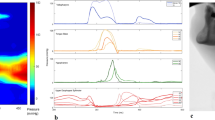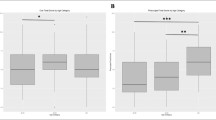Abstract
Purpose
The purpose of this study was to determine whether transnasal passage of a flexible endoscope results in changes in salivary flow rate (SFR), spontaneous swallow frequency (SSF), and masticatory efficiency (ME) in healthy adults.
Methods
Data were collected from 15 healthy adults, 20–63 years of age. SFR and SSF were measured at baseline, after endoscope insertion, and after endoscope removal. The Test of Masticating and Swallowing Solids was administered at baseline and while the endoscope was in the hypopharynx. A repeated measures ANOVA was used to determine the effect of endoscope insertion on SFR and SSF. A paired samples t-test was used to determine the effect of endoscope insertion on total mastication time and number of masticatory cycles required with a cracker bolus. Statistical significance was set at α = 0.05.
Results
SFR was found to be significantly increased during endoscope placement in the hypopharynx (M = 0.471 g/min, SD = 0.175, p = 0.002) as well as following endoscope removal (M = 0.481 g/min, SD = 0.231, p = 0.004), as compared to baseline (M = 0.310 g/min, SD = 0.130). Total mastication time and number of masticatory cycles required with a cracker bolus were significantly decreased when the endoscope was present in the hypopharynx, as compared to baseline t(14) = 3.054, p = 0.009; t(14) = 3.250, p = 0.006, respectively.
Conclusions
Visualization of swallowing during FEES is an important method for objectively evaluating several anatomical and functional parameters of the pharynx and larynx. Insertion of the endoscope into the hypopharynx during FEES may stimulate salivary secretion and improve ME, which could influence interpretation of FEES and resulting clinical recommendations.




Similar content being viewed by others
Data availability
Data are available upon request from the corresponding author.
References
Dawes C, Pedersen AML, Villa A, Ekström J, Proctor GB, Vissink A, Aframian D, McGowan R, Aliko A, Narayana N, Sia YW, Joshi RK, Jensen SB, Kerr AR, Wolff A (2015) The functions of human saliva: a review sponsored by the world workshop on oral medicine VI. Arch Oral Biol 60:863–874. https://doi.org/10.1016/j.archoralbio.2015.03.004
Edgar M, Dawes C, Saliva DO (2012) Saliva and oral health an essential overview for the health professional fourth edition. https://www.semanticscholar.org/paper/Saliva-and-oral-health-an-essential-overview-for-Edgar-Dawes/2dacd25944d8257b30f71ff4e1543323ade10c4a. Accessed 15 Apr 2022
Mandel ID (1987) The functions of saliva. J Dent Res 66:623–627. https://doi.org/10.1177/00220345870660S203
Pedersen A, Sørensen CE, Proctor GB, Carpenter GH (2018) Salivary functions in mastication, taste and textural perception, swallowing and initial digestion. Oral Dis 24:1399–1416. https://doi.org/10.1111/odi.12867
Humphrey SP, Williamson RT (2001) A review of saliva: normal composition, flow, and function. J Prosthet Dent 85:162–169. https://doi.org/10.1067/mpr.2001.113778
Proctor GB, Carpenter GH (2007) Regulation of salivary gland function by autonomic nerves. Auton Neurosci 133:3–18. https://doi.org/10.1016/j.autneu.2006.10.006
Proctor GB, Carpenter GH (2014) Salivary secretion: mechanism and neural regulation. Monogr Oral Sci 24:14–29. https://doi.org/10.1159/000358781
Hutchings JB, Lillford PJ (1988) The perception of food texture - the philosophy of the breakdown path. J Texture Stud 19:103–115. https://doi.org/10.1111/j.1745-4603.1988.tb00928.x
Amerongen AVN, Veerman ECI (2002) Saliva–the defender of the oral cavity. Oral Dis 8:12–22. https://doi.org/10.1034/j.1601-0825.2002.1o816.x
Lagerlöf F, Dawes C (1984) The volume of saliva in the mouth before and after swallowing. J Dent Res 63:618–621. https://doi.org/10.1177/00220345840630050201
Kapila YV, Dodds WJ, Helm JF, Hogan WJ (1984) Relationship between swallow rate and salivary flow. Digest Dis Sci 29:528–533. https://doi.org/10.1007/BF01296273
Nederkoorn C, Smulders FTY, Jansen A (1999) Recording of Swallowing events using electromyography as a non-invasive measurement of salivation. Appetite 33:361–369. https://doi.org/10.1006/appe.1999.0268
Rudney JD, Ji Z, Larson CJ (1995) The prediction of saliva swallowing frequency in humans from estimates of salivary flow rate and the volume of saliva swallowed. Arch Oral Biol 40:507–512. https://doi.org/10.1016/0003-9969(95)00004-9
Bulmer JM, Ewers C, Drinnan MJ, Ewan VC (2021) Evaluation of spontaneous swallow frequency in healthy people and those with, or at risk of developing, dysphagia: a review. Gerontol Geriatr Med 7:23337214211041800. https://doi.org/10.1177/23337214211041801
Murray J, Langmore SE, Ginsberg S, Dostie A (1996) The significance of accumulated oropharyngeal secretions and swallowing frequency in predicting aspiration. Dysphagia 11:99–103. https://doi.org/10.1007/BF00417898
Palsy S (2021) 28th Annual meeting of the dysphagia research society. Dysphagia 36:1118–1184. https://doi.org/10.1007/s00455-020-10221-z
WHO (1992) WHO expert coomittee on recent advances in oral health. Recent advances in oral health: report of a WHO expert committee. WHO technical report series. World Health Organization, Geneva, p 38
Abe K, Weisz SEM, Dunn RL, DiGioacchino MC, Nyentap JA, Stanbouly S, Theurer JA, Bureau Y, Affoo RH, Martin RE (2015) Occurrences of yawn and swallow are temporally related. Dysphagia 30:57–66
Navazesh M (1993) Methods for collecting saliva. Ann N Y Acad Sci 694:72–77. https://doi.org/10.1111/j.1749-6632.1993.tb18343.x
Shannon IL (1969) Specific gravity and osmolality of human parotid fluid. CRE 3:149–158. https://doi.org/10.1159/000259578
Huckabee M-L, McIntosh T, Fuller L, Curry M, Thomas P, Walshe M, McCague E, Battel I, Nogueira D, Frank U, van den Engel-Hoek L, Sella-Weiss O (2018) The Test of Masticating and Swallowing Solids (TOMASS): reliability, validity and international normative data. Int J Lang Commun Disord 53:144–156. https://doi.org/10.1111/1460-6984.12332
Faul F, Erdfelder E, Lang A-G, Buchner A (2007) G*Power 3: a flexible statistical power analysis program for the social, behavioral, and biomedical sciences. Behav Res Methods 39:175–191
Affoo RH, Trottier K, Garrick R, Mascarenhas T, Jang Y, Martin RE (2018) The effects of tooth brushing on whole salivary flow rate in older adults. Biomed Res Int 2018:3904139. https://doi.org/10.1155/2018/3904139
Glass GV, Peckham PD, Sanders JR (1972) Consequences of failure to meet assumptions underlying the fixed effects analyses of variance and covariance. Rev Educ Res 42:237–288. https://doi.org/10.3102/00346543042003237
Portney L, Watkins M (2000) Foundations of clinical research: applications to practice, 3rd edn. Prentice Hall, New Jersey
Ishijima T, Koshino H, Hirai T, Takasaki H (2004) The relationship between salivary secretion rate and masticatory efficiency. J Oral Rehabil 31:3–6. https://doi.org/10.1111/j.1365-2842.2004.01033.x
Milford EM, Wang B, Smith K, Choi D, Martin-Harris B, Garand KLF (2020) Aging and sex effects on mastication performance in healthy, nondysphagic, community-dwelling adults. Am J Speech Lang Pathol. https://doi.org/10.1044/2019_AJSLP-19-00097
Ikebe K, Matsuda K, Morii K, Furuya-Yoshinaka M, Nokubi T, Renner RP (2006) Association of masticatory performance with age, posterior occlusal contacts, occlusal force, and salivary flow in older adults. Int J Prosthodont 19:475–481
Pereira LJ, Duarte Gaviao MB, Van Der Bilt A (2006) Influence of oral characteristics and food products on masticatory function. Acta Odontol Scand 64:193–201. https://doi.org/10.1080/00016350600703459
Dawes C (2005) The unstimulated salivary flow rate after prolonged gum chewing. Arch Oral Biol 50:561–563. https://doi.org/10.1016/j.archoralbio.2004.10.016
Shimada A, Baad-Hansen L, Svensson P (2015) Effect of experimental jaw muscle pain on dynamic bite force during mastication. Arch Oral Biol 60:256–266. https://doi.org/10.1016/j.archoralbio.2014.11.001
Acknowledgements
A version of this study has been published in an abstract form [16]. This work would not be possible without the generous support of the participants.
Funding
This work was completed with Central Michigan University Internal Research Support (RHA).
Author information
Authors and Affiliations
Corresponding author
Ethics declarations
Conflict of interest
The authors have no competing interests to declare that are relevant to the content of this article.
Additional information
Publisher's Note
Springer Nature remains neutral with regard to jurisdictional claims in published maps and institutional affiliations.
Rights and permissions
Springer Nature or its licensor (e.g. a society or other partner) holds exclusive rights to this article under a publishing agreement with the author(s) or other rightsholder(s); author self-archiving of the accepted manuscript version of this article is solely governed by the terms of such publishing agreement and applicable law.
About this article
Cite this article
Affoo, R.H., Nellenbach, C., Chomchai, J. et al. The effects of endoscope placement in the hypopharynx on swallowing-related measures in healthy adults. Eur Arch Otorhinolaryngol 280, 4979–4985 (2023). https://doi.org/10.1007/s00405-023-08114-6
Received:
Accepted:
Published:
Issue Date:
DOI: https://doi.org/10.1007/s00405-023-08114-6




